

Standards based teaching. Parents Buy into Potential of Ed Tech; Most Don't See Learning Results. Research Parents Buy into Potential of Ed Tech; Most Don't See Learning Results By Dian Schaffhauser10/25/16 While plenty of surveys examine the use of technology in schools from the teacher or student perspective, here's one that looks at the subject from the parents' point of view.
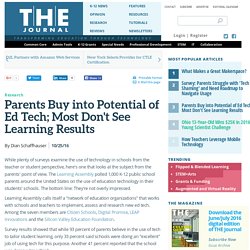
The Learning Assembly polled 1,000 K-12 public school parents around the United States on the use of education technology in their students' schools. The bottom line: They're not overly impressed. Learning Assembly calls itself a "network of education organizations" that works with schools and teachers to implement, assess and research new ed tech. Survey results showed that while 93 percent of parents believe in the use of tech to tailor student learning, only 33 percent said schools were doing an "excellent" job of using tech for this purpose. Also, most parents surveyed said they aren't confident that they understand some of the new concepts permeating schools today. About the Author. Visualizing 21st-Century Classroom Design. Problem-based learning, makerspaces, flipped learning, student blogging -- these are becoming perceived staples of 21st-century learning.
With such ambitious practices taking the spotlight for how people regard modern classrooms, it's not surprising that a murmur of impracticality or skepticism is still a frequent response when they're first introduced. So how do we encourage teachers everywhere to believe that great changes can happen in their classrooms? By helping them envision small, practical steps that will lead them there. Here are five elements of 21st-century classrooms, along with concrete suggestions that teachers can visualize and implement today. Rethinking Learning – Barbara Bray. We are Barbara Bray and Kathleen McClaskey, Co-Founders of Personalize Learning, LLC, who are researching and learning so much about Personalizing Learning.

You can download the resources from this page. Please ask us permission to make copies or to post on your site: personalizelearn@gmail.com Use the link below download the Personalization vs Differentiation vs Individualization version 3 chart. Personalization v Differentiation v Individualization v3. Dismantling Personalized Learning Myths. “A deeper understanding of the child empowers us as educators to deepen relationships and educate appropriately and proactively.” – Kathy Walker Personalized Learning (PL) looks different in every district because it is just that, personalized to fit each districts students needs.

For example, check out Charlotte-Mecklenburg Schools in NC and Henry County in GA approaches to PL. The foundation of Personalized Learning is the same, classrooms are student centered with an emphasis on student ownership of their learning. There are many myths out there about PL and in this blog post it is time we dismantle them. Myth #1. Myth #2. Myth #3. As I See It: Kids aren't cogs, personlize learning for best results - Harrisburg Academy BlogHarrisburg Academy Blog. By Jim Newman, as originally published in The Patriot-News / PennLive.com.

Last month marked the 30th anniversary of “A Nation at Risk,” a study commissioned by the Department of Education. At once a strong indictment of the academic performance of American students, it also set forth numerous recommendations intended to improve the curriculum, learning standards and instruction, particularly in American secondary schools. Since its publication, concern for American education has grown. In 1983, the focus was on the achievement gap among American students. Today, that concern has expanded to encompass a “global achievement gap.” To the credit of school and business leaders, teachers and graduate schools of education, efforts to reform American education have been extensive. Our schools have benefited from decades of research on cognition and child development, and the intersection of that research with teacher training, curriculum design and instructional technologies.
Purpose Driven Learning - Lessons. Learning A Sense Makers guide1. Starting Small but Dreaming Big to Personalize Learning. Guest Post by Bryan Bronn, Principal, Branson Junior High, Missouri At Branson Junior High, our amazing team of teachers and principals, along with the encouraging support of our school district superintendents to be innovative with a purpose, are on a journey to personalize learning for every child.
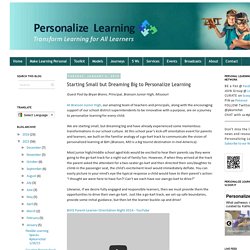
We are starting small, but dreaming big and have already experienced some momentous transformations in our school culture. What Is Personalized Learning? - Verona Area School District. What is Personalized Learning?
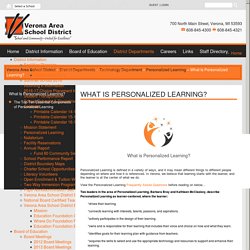
Personalized Learning is defined in a variety of ways, and it may mean different things to different people depending on where and how it is referenced. In Verona, we believe that learning starts with the learner, and the learner is at the center of what we do. Five Ways to Create More Teacher Rockstars in Your School. “Rockstar” is a term that is being thrown around among educators lately.
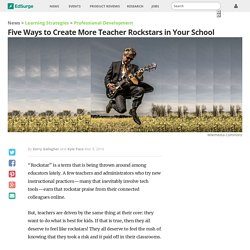
A few teachers and administrators who try new instructional practices—many that inevitably involve tech tools—earn that rockstar praise from their connected colleagues online. But, teachers are driven by the same thing at their core: they want to do what is best for kids. If that is true, then they all deserve to feel like rockstars! They all deserve to feel the rush of knowing that they took a risk and it paid off in their classrooms. Here are five ways school leaders can create a culture that motivates all teachers in your school to take a risk and try something new. 1. We have all heard it while crowding around the microwave waiting to warm up lunch or pacing the playground for recess duty. School leaders can tap into those smaller conversations and spread that excitement. The Myth of Average: Todd Rose at TEDxSonomaCounty. Curating Resources in Education - home. Sir Ken Robinson: Bring on the learning revolution! A new shape for schooling 11.
Personalizing 21st Century Education: A Framework for Student Success - Dan Domenech, Morton Sherman, John L. Brown. Personalizing 21st Century Education: A Framework for Student Success (Jossey-Bass, an imprint of Wiley; Available March 2016; ISBN: 978-1-119-08077-0; $29.95, Paper) begins with a manifesto for change, emphasizing the significance of true personalization for every learner.

Next, it describes classroom, school, and system-level performance indicators that suggest that personalization is alive and well. The authors examine the historical origins of most modern school cultures—i.e., a commitment to standardization, depersonalization, and test-driven metrics that ignore the complexity and totality of the whole child. It’s Personal! Help Students Become Masters of Their Own Learning - edu Pulse. One district’s discovery of what personal learning is, and is not.

Continuum of Voice: What it Means for the Learner. Voice gives learners a chance to share their opinions about something they believe in.
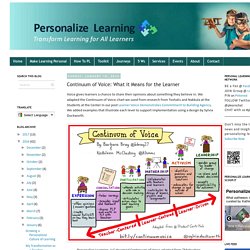
We adapted the Continuum of Voice chart we used from research from Toshalis and Nakkula at the Students at the Center in our post Learner Voice Demonstrates Commitment to Building Agency. We added examples that illustrate each level to support implementation using a design by Sylvia Duckworth. Personalize Learning, LLC designed Continuum of Voice adapted from "Motivation, Engagement, & Student Voice" by Toshalis & Nakkula from Students at the Center @StudentcCntrHub - Visual designed by Sylvia Duckworth @sylviaduckworth. Personalized Learning & One-to-One Initiative - Sagewood Middle School. 20 Collaborative Learning Tips And Strategies For Teachers. 20 Collaborative Learning Tips And Strategies For Teachers by Miriam Clifford This post has been updated from a 2011 post. There is an age old adage that says “two heads are better than one”. Strategies for Teaching Blended Learning Courses, Maybe You (and Your Students) Can Have It All Faculty Focus.
Blended learning, which combines face-to-face and online learning activities into a single course, has experienced tremendous growth during the past few years. A blended learning course (also called a hybrid course) can satisfy students’ need for flexibility, as well as alleviate overcrowded classrooms. However, the biggest benefit to a well-designed blended course could be a much improved teaching and learning experience. It’s for this reason that blended learning, grounded in sound pedagogical theory, is creating converts among faculty and administrators alike. One such convert is Ike Shibley, associate professor of chemistry at Penn State University-Berks, who says the students in his blended courses are not only more engaged when they come to class, but are performing better on their final exams than his previous, traditional classes. 1. 2.
20 Collaborative Learning Tips And Strategies For Teachers. Personalized Learning Webinar with Michael Horn [Recorded] Personalized Learning: Students Use pH Probes To Watch Chemistry Take Shape in Real Time. Use of Vernier technology has become widespread in the Science department this year. Almost every student in the school has now had an opportunity to experience the LabQuest 2, along with various probes and sensors, in their science classes. Recently, the Grade 12 Chemistry class used the LabQuest with pH probes while conducting a titration to determine the Ksp (solubility product constant) of calcium hydroxide.
Having performed several titrations in Grade 11, this procedure was fairly routine. Using this new technology, however, the experiment was really brought to life. Mo Physics Mo Problems: A Leap for Me Is a Baby Step in Personalization. I’ve been on the journey to bring personalized learning to my classroom for 3 years now. It seems that every time I think I’ve taken a big step forward, I look and see that in the grand scheme of bringing true voice/choice/agency to my students, I’m still add drops to a big bucket. That’s not meant to be a cynical statement. It’s meant to see how much room I have to grow. In an attempt to try to take another small leap forward, I tried something different with my current unit in AP Physics. This might seems like personalization 101, but it was a big leap for me in terms of demand and supply.
The unit I’m focusing on is Electromagnetic Induction. The first 3 days of the unit were fairly traditional. Scott McLeod (mcleod) What Personalized Learning Plans Do For Students (Deeper Learning) RSU2: Entering a New Stage in Building a High Quality Proficiency-Based District. This post is part of the Maine Road Trip series. RSU2: Entering a New Stage in Building a High Quality Proficiency-Based District. Is this a breakthrough idea?
Disclaimer: This blog post is just an idea. All Things Social Studies: #Stuvoice: Hoover: Top 10 Worst President? I don't know about you, but I don't often hear two 17 year olds arguing about President Hoover in terms of both his place in history and the parallels with the Obama Administration. Learning Centers in the Secondary Classroom. As teachers strive to find ways of promoting key success skills while making use of limited resources, learning centers can be an invaluable tool in the secondary classroom. Middle School Maker Journey: Assessment in an Ungraded Classroom. "I'm done! " Those two words have extra special meaning in my program because, generally speaking, student design work is never really finished -- it's just ready for another iteration.
Blended Learning: Personalizing Education for Students - New Teacher Center, Silicon Schools Fund & Clayton Christensen Institute. Personalized and Student-Centered Learning. Starts February 9, 2015. Chris Lehmann presentations channel. Diana Laufenberg — Science Leadership Academy. Science Leadership Academy. The Blended Learner - home. Member Practices : EdLeader21. By Valerie Truesdale, Chief Officer, Technology, Personalized Learning and Engagement, for Charlotte-Mecklenburg Schools (NC) In 2013, Charlotte-Mecklenburg Schools completed a new Strategic Plan 2018, with Goal One to "maximize academic achievement in a personalized 21st century learning environment for every child to graduate career and college-ready" and Goal Six to "inspire and nurture learning, creativity, innovation and entrepreneurship through technology and strategic school redesign.
" The Plan defines Essential Learning Skills as creativity, communication, critical thinking, collaboration and entrepreneurship. My collection of resources on #GeniusHour - Angela Maiers. Four years ago, we imagined a classroom where passion driven work was the norm; one in which students were invited and expected to experiment with ideas, discover possibilities, and make epic things happen. This dream is now a reality. When we create a time and space for our students to strive audaciously and connect and collaborate with others, their genius is liberated, and learning, lives and worlds change. 10 Questions to Ask When Planning Tech Infused Units. Make Learning Relevant. 10 Questions to Ask When Planning Tech Infused Units. 5. Integrating Technology: Eight Questions to Ask Yourself - Journal of Technology for ELT.
Problem loading page. CCSD Personalized Learning - Blog. CCSD Grants: RTT. Embarking on the Personalized Learning Journey - Home. Vision 2020 ... The Students - Lessons. Innovation Often Means Teaching Against The Grain. 9 Ways to Provide Choice in Your Classroom. 9 Ways to Provide Choice in Your Classroom.